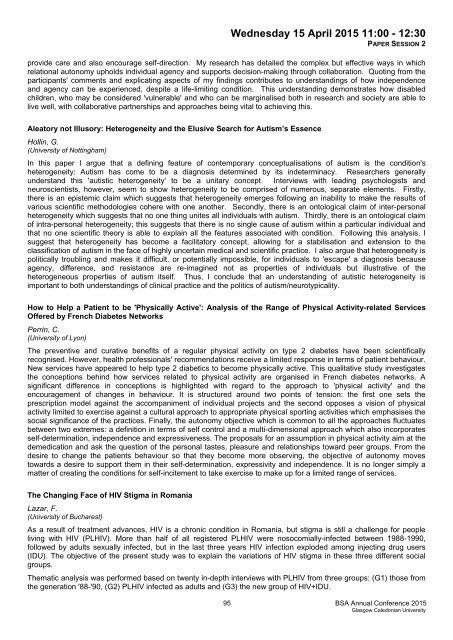Programme full
Programme full
Programme full
Create successful ePaper yourself
Turn your PDF publications into a flip-book with our unique Google optimized e-Paper software.
Wednesday 15 April 2015 11:00 - 12:30<br />
PAPER SESSION 2<br />
provide care and also encourage self-direction. My research has detailed the complex but effective ways in which<br />
relational autonomy upholds individual agency and supports decision-making through collaboration. Quoting from the<br />
participants' comments and explicating aspects of my findings contributes to understandings of how independence<br />
and agency can be experienced, despite a life-limiting condition. This understanding demonstrates how disabled<br />
children, who may be considered 'vulnerable' and who can be marginalised both in research and society are able to<br />
live well, with collaborative partnerships and approaches being vital to achieving this.<br />
Aleatory not Illusory: Heterogeneity and the Elusive Search for Autism’s Essence<br />
Hollin, G.<br />
(University of Nottingham)<br />
In this paper I argue that a defining feature of contemporary conceptualisations of autism is the condition's<br />
heterogeneity: Autism has come to be a diagnosis determined by its indeterminacy. Researchers generally<br />
understand this 'autistic heterogeneity' to be a unitary concept. Interviews with leading psychologists and<br />
neuroscientists, however, seem to show heterogeneity to be comprised of numerous, separate elements. Firstly,<br />
there is an epistemic claim which suggests that heterogeneity emerges following an inability to make the results of<br />
various scientific methodologies cohere with one another. Secondly, there is an ontological claim of inter-personal<br />
heterogeneity which suggests that no one thing unites all individuals with autism. Thirdly, there is an ontological claim<br />
of intra-personal heterogeneity; this suggests that there is no single cause of autism within a particular individual and<br />
that no one scientific theory is able to explain all the features associated with condition. Following this analysis, I<br />
suggest that heterogeneity has become a facilitatory concept, allowing for a stabilisation and extension to the<br />
classification of autism in the face of highly uncertain medical and scientific practice. I also argue that heterogeneity is<br />
politically troubling and makes it difficult, or potentially impossible, for individuals to 'escape' a diagnosis because<br />
agency, difference, and resistance are re-imagined not as properties of individuals but illustrative of the<br />
heterogeneous properties of autism itself. Thus, I conclude that an understanding of autistic heterogeneity is<br />
important to both understandings of clinical practice and the politics of autism/neurotypicality.<br />
How to Help a Patient to be 'Physically Active': Analysis of the Range of Physical Activity-related Services<br />
Offered by French Diabetes Networks<br />
Perrin, C.<br />
(University of Lyon)<br />
The preventive and curative benefits of a regular physical activity on type 2 diabetes have been scientifically<br />
recognised. However, health professionals' recommendations receive a limited response in terms of patient behaviour.<br />
New services have appeared to help type 2 diabetics to become physically active. This qualitative study investigates<br />
the conceptions behind how services related to physical activity are organised in French diabetes networks. A<br />
significant difference in conceptions is highlighted with regard to the approach to 'physical activity' and the<br />
encouragement of changes in behaviour. It is structured around two points of tension: the first one sets the<br />
prescription model against the accompaniment of individual projects and the second opposes a vision of physical<br />
activity limited to exercise against a cultural approach to appropriate physical sporting activities which emphasises the<br />
social significance of the practices. Finally, the autonomy objective which is common to all the approaches fluctuates<br />
between two extremes: a definition in terms of self control and a multi-dimensional approach which also incorporates<br />
self-determination, independence and expressiveness. The proposals for an assumption in physical activity aim at the<br />
demedication and ask the question of the personal tastes, pleasure and relationships toward peer groups. From the<br />
desire to change the patients behaviour so that they become more observing, the objective of autonomy moves<br />
towards a desire to support them in their self-determination, expressivity and independence. It is no longer simply a<br />
matter of creating the conditions for self-incitement to take exercise to make up for a limited range of services.<br />
The Changing Face of HIV Stigma in Romania<br />
Lazar, F.<br />
(University of Bucharest)<br />
As a result of treatment advances, HIV is a chronic condition in Romania, but stigma is still a challenge for people<br />
living with HIV (PLHIV). More than half of all registered PLHIV were nosocomially-infected between 1988-1990,<br />
followed by adults sexually infected, but in the last three years HIV infection exploded among injecting drug users<br />
(IDU). The objective of the present study was to explain the variations of HIV stigma in these three different social<br />
groups.<br />
Thematic analysis was performed based on twenty in-depth interviews with PLHIV from three groups: (G1) those from<br />
the generation '88-'90, (G2) PLHIV infected as adults and (G3) the new group of HIV+IDU.<br />
95 BSA Annual Conference 2015<br />
Glasgow Caledonian University


